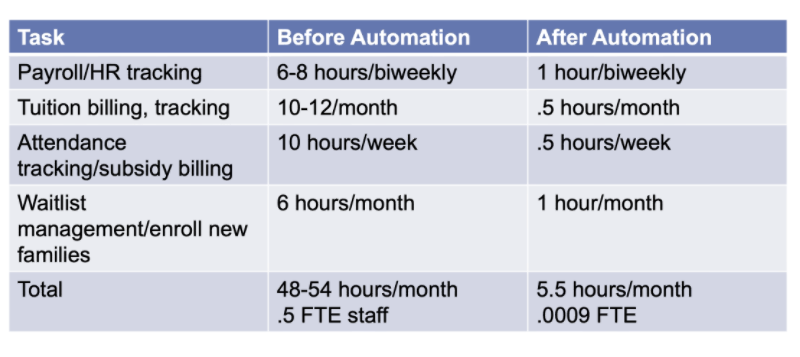
It’s a persistent issue for child care leaders: how do you pay your staff a reasonable wage without raising tuition to exorbitant levels where families can’t afford it?
The Center for the Study of Child Care Employment says the annual average expense of child care rivals the cost of college tuition, but, conversely, child care jobs are some of the lowest paying in the U.S. – even though many teachers have college degrees. Additionally, the tuition most daycare centers charge often doesn’t cover the full cost of care – especially for infants and toddlers
The System is Broken
In short, the system is broken. Teachers aren’t being paid enough, parents struggle to cover the cost of their children’s care, and child care centers are barely breaking even. No one is benefitting from this scenario.
Consider these shocking facts:
- Child care is the largest household expense for many families
- The average early educator earns $12.12 per hour, which doesn’t meet the living wage threshold for a single adult with one child in any U.S. state
- Wages are even lower for educators of color, who make up 40 percent of the national early child care workforce
Sixty-five percent of a child care center’s budget goes toward personnel costs, and about half of that is for administrative staff Additionally, child care teachers are often required to have specific knowledge, education and skills to work with small children. Thirty-five percent have a bachelor’s degree or higher and 17 percent have an associate’s degree. Because of those requirements, they should be recognized as well-compensated professionals working in complex jobs. Unfortunately, their salaries fall far short of similar professionals, such as kindergarten teachers, who make, on average, $54,230 per year compared to $22,290 per year for child care teachers.
Low Wages Drive Turnover
Child care center leaders are well aware the impact this situation is having on their workforce: a Nebraska study found that the annual turnover rate for child care teachers is 26 percent. Teachers said low pay was the most common reason they left their jobs followed by not receiving benefits. These issues also make it difficult to recruit new employees.
The solution isn’t to ask parents to pay more when most are already struggling to afford tuition. Instead, child care centers need to carefully examine their businesses’ operations, and look for ways to cut costs while boosting efficiency.
Reduce Administrative Costs
In a recent webinar, child care technology experts Louise Stoney and Sharon Easterling explained that one of the key areas to target for cost reductions is administrative staff who are responsible for payroll, tuition tracking, attendance tracking and subsidy billing, waitlist management, and enrolling new families. These tasks can commonly take up to 48-54 hours each month.

By automating these tasks with a CCMS (child care management software), the time it takes to complete them can be reduced to just 5.5 hours each month, a massive 91 percent reduction.
Administrative staff’s salaries are typically 30-40 percent of the total amount that child care centers spend on all employees’ salaries. With a CCMS, you’ll reduce the time administrative staff spend on operations, so you can reallocate those salaries to higher wages and enhanced benefits for your teachers.
Reallocate Money Spent on Administrative Expenses to Teachers’ Salaries
Does reducing administrative expenses actually make a financial difference? Louise and Sharon recall a child care center that reduced its administrative costs up to $52,00 in the first year of implementing a CCMS. Previously, the center struggled to collect bad debt and maintain high enrollment, because its director was too busy to give these items her full attention.
By automating those administrative tasks and others with a CCMS, the center took the $52,000 it saved and immediately set up a 401(k) plan for its teachers and enhanced existing benefits. However, this wasn’t a one-time savings: projections show that the efficiencies the child care center gained by implementing a CCMS and automating tasks will continue to pay big financial dividends in the future, too.
A CCMS can make the difference in whether your child care center’s teachers are well compensated for their highly skilled work. By automating administrative tasks, you’ll streamline processes and reduce costs – creating savings that can then be passed on to your teachers to boost retention and increase job satisfaction.



